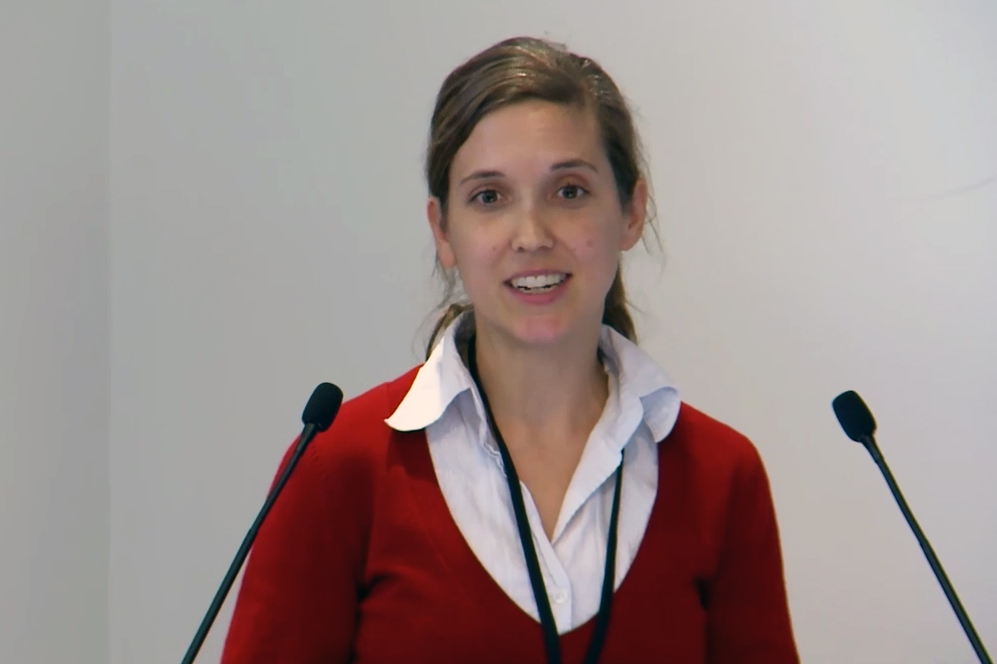Participants in a May 23 public forum highlighted collaborations to replace animal use for U.S. safety testing. Commenters at the meeting praised federal agencies’ activities and involvement with stakeholders.
 Groff is a research associate with PETA.
Groff is a research associate with PETA.“We’ve seen examples of collaborations, commitment to reducing animal testing, and greater communication among different stakeholders,” noted Katherine Groff of People for the Ethical Treatment of Animals (PETA). She specifically recognized federal agency efforts to reduce animal use for testing of pesticides and medical devices.
Representatives of the Interagency Coordinating Committee on the Validation of Alternative Methods (ICCVAM) described federal agencies’ work with animal welfare groups, industry scientists, and other stakeholders to advance new approaches to safety testing of chemicals and medical products in the United States.
The annual ICCVAM Public Forum was held at the National Institutes of Health in Bethesda, Maryland. In addition to animal welfare groups, attendees represented federal agencies, pharmaceutical and chemical companies, and test method developers.
Collaborations evaluate and inform
 Casey directs NICEATM, the agency that provides scientific and administrative support for ICCVAM. (Photo courtesy of Steve McCaw)
Casey directs NICEATM, the agency that provides scientific and administrative support for ICCVAM. (Photo courtesy of Steve McCaw)In response to Groff’s comments, National Toxicology Program (NTP) scientist Warren Casey, Ph.D., described animal welfare organizations as “absolutely some of our best collaborators. They are the people we work with day in, day out.” Casey directs the NTP Interagency Center for the Evaluation of Alternative Toxicological Methods (NICEATM), which organized the meeting on behalf of ICCVAM and provides scientific and administrative support to the committee.
Steven Snyderman, of the U.S. Environmental Protection Agency (EPA), provided examples of these collaborations. The agency is partnering with NICEATM, PETA, and other industry and nongovernmental groups to evaluate nonanimal approaches to test pesticides for eye irritation potential. It is also presenting a webinar series in partnership with PETA and the Physicians Committee for Responsible Medicine to raise awareness of available non-animal testing methods.
NICEATM Deputy Director Nicole Kleinstreuer, Ph.D., noted that NICEATM and the PETA International Science Consortium co-organized a 2018 workshop on human cell-based methods for medical device testing. Kleinstreuer also described her group’s coordination of an international collaboration to develop computational methods to predict acute toxicity.
Developmental toxicity is another area of focus, she said. The U.S. Food and Drug Administration, Oak Ridge National Laboratory, and NICEATM are developing text-mining approaches that will identify high-quality developmental toxicity data in published scientific studies.
 Kleinstreuer’s summary of recent activities is described in the update of the NICEATM Integrated Chemical Environment resource. (Photo courtesy of Steve McCaw)
Kleinstreuer’s summary of recent activities is described in the update of the NICEATM Integrated Chemical Environment resource. (Photo courtesy of Steve McCaw)Opportunity for connection
Both co-chairs of ICCVAM noted how the public forum allows them to connect with others both within and outside the government interested in advancing alternatives to animal testing.
“This is one of my favorite days of the ICCVAM calendar,” said Anna Lowit, Ph.D., of EPA. “I get to see what everyone else is doing, which is a lot of fun, and I always walk out of here inspired to do something that I hadn’t thought of yet.” Lowit co-chairs ICCVAM along with Emily Reinke, Ph.D., of the U.S. Department of Defense.
NICEATM has posted a video of the meeting and presenters’ slides on the NTP website.
(Catherine Sprankle, NICEATM Communications Specialist, works for ILS, the contractor supporting NICEATM.)









